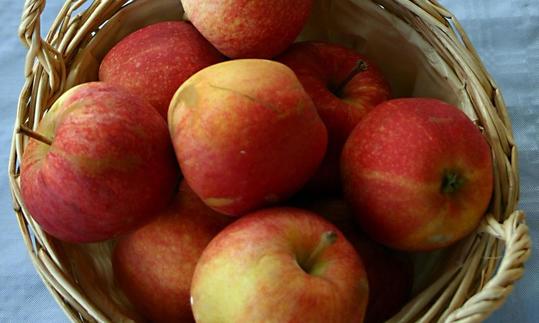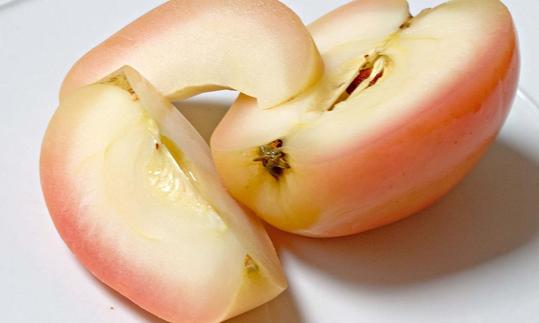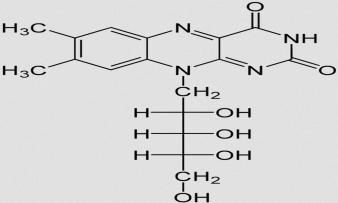Table of contents
The 'Gala' apple variety belongs to the cultivated apple ( Malus domestica ). The small, sweet apple is one of the most popular and has even replaced the 'Golden Delicious' variety in some countries. The low acid content in particular makes the 'Gala' apple very attractive as a dessert fruit and raw apple for children.
Use in the kitchen:
The 'Gala' is a table fruit, its flesh is firm, juicy and pale yellow, the taste is sweet and mild. In comparison, the ' Granny Smith ' variety tastes much more sour due to the high fruit acid content. The skin is smooth and somewhat waxy, the color flat or streaky red. If you rub the apple with a kitchen towel, it gets a beautiful shine. The crisp apple tastes very good with the skin on as a raw vegetable, in muesli, as a fruit salad or grated as a raw vegetable salad with various vegetables.
The small to medium-sized apples are also good for baking, peeled and sliced for baking cakes, flans, strudels, etc. or steamed for compote and apple sauce. Apple juice made from 'Gala' apples also tastes excellent and dried apple rings made from this apple variety are particularly sweet.
Vegan recipe for apple pie:
Ingredients : 200 g whole wheat flour , 100 g raw cane sugar , 100 g cold vegan margarine and approx. ½ teaspoon for greasing, 1 pinch of salt . For the topping: 750 g 'Gala' apples, 4 tablespoons lemon juice , ¼ teaspoon Bourbon vanilla , 1 ½ teaspoons ground cinnamon, 2 tablespoons sultanas (raisins) . For the crumble: 100 g wheat flour , 50 g margarine, 50 g raw cane sugar , 1 pinch of salt.
Preparation : For the shortcrust pastry, quickly mix the flour, sugar, chopped margarine and salt by hand or in a food processor to form a crumbly dough. Form into a ball, cover and leave to rest in the fridge until the next step.
In the meantime, wash, peel, quarter and core the apples. Cut the quartered pieces into 3 mm thin slices and mix with lemon juice. Add the vanilla, cinnamon and sultanas and fold in. Now preheat the oven to 180 °C top / bottom heat. Line a springform pan with a diameter of approx. 24 cm with baking paper and grease the edge. Spread the shortcrust pastry evenly in the pan and flatten it. Use the dough to form an approx. 2 cm high edge (e.g. with the back of a spoon). Spread the sliced apples on the cake base. For the crumble, mix all the ingredients together and process by hand or with a mixer to make coarse crumbles. Spread evenly on the cake. Bake on the middle shelf for approx. 40-50 minutes, allow the cake to cool before serving and remove from the springform pan.
Vegan recipe for apple sweetness or apple syrup:
Ingredients : 1.5 kg 'Gala' apples (alternatively another sweet variety, such as 'Golden Delicious'), 4x250 ml sterilized screw-top jars or small glass bottles.
Preparation : Wash the apples, quarter them and juice them with a juicer. A medium-fine pomace sieve is suitable for this. You will have around 1.2 l of apple juice and around 400 g of pomace left. Now boil the apple juice in a pan for around 20 minutes and reduce it to around 1 l. Pour the thick juice into the clean jars while it is still hot, seal them and leave to cool. The apple sweetness will keep for around 4-6 weeks in the fridge, but it will last much longer if frozen. Apple sweetness can be used instead of sugar to sweeten cakes, biscuits or bread, similar to agave syrup . The pomace will keep for around 2-3 days in the fridge and is suitable for baking cakes and thickening sauces.
Vegan recipes with apple variety 'Gala' can be found under the note: " Recipes that have the most of this ingredient ".
| Not only vegans or vegetarians should read this: Vegans often eat unhealthily. Avoidable nutritional mistakes . |
Shopping - where to buy?
Aromatic, sweet 'Gala' apples are available almost all year round in all standard supermarkets such as Coop , Migros , Denner , Volg , Spar , Aldi , Lidl , Rewe , Edeka , Hofer etc. Organically produced apples of this variety can also be found at weekly markets, in organic shops or organic supermarkets ( Denn's Biomarkt , Alnatura ).
A ripe 'Gala' has a creamy yellow to golden yellow background and an intense red color on the surface. If the background color is green, the apple is not yet fully ripe. A beautiful ripe color depends very much on the amount of sunlight during the growth phase.
Storage:
Special industrial storage under a controlled atmosphere (CA or DCA storage) means that 'Gala' apples can be stored for around a year. This variety can also be stored well at temperatures of around 4 °C in a dark cellar, in frost-proof garages or in cool attics. It is important that the apples are not yet fully ripe and that only first-class fruit without rot or fungal diseases is stored. 1 They should not touch each other and should be placed with the stem facing downwards on a shelf or in a wooden or plastic box (with holes). Apples should always be stored separately from other types of fruit and vegetables, as the ripening gas ethylene accelerates the ripening process of their neighbours and shortens their shelf life. 2 After a long period of storage, the skin of Gala apples can appear a little greasy. However, this is not a quality criterion; the waxy layer is the apple's natural protection against water loss and against pathogens. Within the EU, commercial fruit growing is also permitted to apply an artificial wax layer made of beeswax, carnauba wax (from the Brazilian carnauba palm) or shellac (from lac scale insects). 3
You should avoid freezing raw apples, as they lose too much of their taste and aroma; their consistency is also different after thawing. However, if you cut them into pieces and blanch them briefly, you can keep them in the freezer for around 6 months and then use them to make apple sauce or cake without any problem.
Ingredients - nutritional value - calories:
A 'Gala' apple has an energy content of approx. 57 kcal/100g. Proteins and fats are barely present, the carbohydrate content makes up approx. 14%, of which approx. 2.3% is fiber.
This type of apple with peel has around 108 mg of potassium per 100 g. That is comparable to pineapple or basmati rice , and grape juice and lemon juice also have a similar amount of this essential element. Compared to dried porcini mushrooms , which contain 2,000 mg/100g (covers 100% of the daily requirement), it is not very much, but with a good combination you can contribute something to the daily requirement. In addition to maintaining the osmotic pressure in the cells, potassium is also responsible for cell growth and normal blood pressure. 4
Apples also contain small amounts of valuable vitamins, including vitamin B 6 (pyridoxine) . At 0.5 mg/100g, the values are similar to those of sweet cherries , strawberries or plums . However, if you want to cover your daily requirement, you need around 1.4 mg daily; this is contained in 100 g of sunflower seeds or dried onions . Pyridoxine is a water-soluble vitamin that is involved in many enzymatic reactions and also plays an important role in protein metabolism. 4
Apples also contain some thiamine (vitamin B 1 ) (0.02 mg/100g). Red chicory orpreserved sweetcorn contain just as much thiamine. However, macadamia nuts contain much more at 1.2 mg/100g, which is more than the daily requirement. This water-soluble vitamin can also be found in the outermost layer of grains: wheat germ has 1.9 mg/100g. This B vitamin is important for energy and carbohydrate metabolism. 4
Folate is also found in apples, but at 3 µg/100g, the proportion of the daily requirement (300 µg) 5 is not particularly high. Quinces , watermelons , garlic and cranberries also have the same value. In combination with, for example, short grain rice (231 µg/100g), lupine flour (188 µg/100g) or quinoa (184 µg/100g), the folic acid content in the diet can certainly be increased. Folic acid plays an important role in cell growth and protein metabolism, among other things. 4 Women have an increased requirement of around 550 µg, especially before and during pregnancy. 5
In particular, the secondary plant substances in apples with peel have been shown to have an important antioxidant effect.
The complete ingredients of apples of the variety 'Gala' , the coverage of the daily requirement and comparison values with other ingredients can be found in our nutrient tables. In the article Nutrients explained you will get a detailed insight into the topic. CLICK FOR before the text.
Health aspects - effects:
Dangers - intolerances - side effects:
The current commercial varieties require up to 30 sprayings per season. Tests are usually only carried out on individual pesticides, for which the CMA ( Central Marketing Society of the German Agricultural Industry ) assures that the residues are below the limit values. Unfortunately, there are no detailed tests on the total contamination of an apple by several pesticides. 'Gala', like 'Braeburn', 'Golden Delicious', 'Granny Smith' and 'Jonagold', is one of the commercially available apple varieties to which people who are allergic to apples very often react. We can only speculate whether there is a connection here.
One study found that subjects who ate low-allergen apples such as 'Alkeme', 'Eifeler Rambur', 'Goldparmäne', 'Gravensteiner', 'Jonathan' and 'Boskoop' were able to tolerate apples from the store better after about 3 months. People who are allergic to apples are usually also allergic to pollen from hazel, alder or birch. This is caused by allergens that are similar to the allergens in birch pollen (so-called "cross-reactivity"). 6
Occurrence - Origin:
Is 'Gala' an old apple variety? Apple variety 'Gala' is a New Zealand variety created by James Hutton Kidd. By crossing 'Cox Orange' with 'Red Delicious' he obtained the variety 'Kidds Orange Red'. He crossed this with 'Golden Delicious' in 1934 and thus obtained the variety 'Gala', which he brought onto the market in 1965. 7
The 'Gala' variety is also one of the most important varieties in Germany and Switzerland. However, the majority of imports for Europe come from New Zealand and Chile. This variety is also very important for commercial cultivation in Brazil, Argentina, China, the USA, France and Great Britain. 7
The discovery of mutants (1970) that were significantly redder in color than the original 'Gala' variety increased the importance of the apple on the world market. Examples of these are the varieties 'Gala Royal', 'Tenroy', 'Gala Must' and others. The 'Royal Gala' is still a little smaller than the normal 'Gala'. 'Gala Galaxy' has been the most commonly grown type since 2005. These variants cannot be grown stably. 7 'Gala' is more interesting because of its intense red color and the firmness of the flesh than because of its taste. The color was also the main focus when breeding the 'Red Delicious' variety, the taste was more of a secondary factor, which is why this variety lost importance again. 8
According to market research, appearance, eating quality and long availability are important criteria for consumers when purchasing and accepting an apple variety. 9
Cultivation - Harvest:
For table fruit, as is the case with the 'Gala' variety, weak-growing rootstocks are usually used to limit the height growth and to make harvesting easier. When trained as spindles (often in plantations), the trees reach a height of around 2 m, and the trunk is 0.4 to 0.5 m high. The variety is only self-fertile to a limited extent. Pollinating varieties include 'Cox Orange', 'Gloster' and 'Jonathan'.
Apples of the 'Gala' variety are very high-maintenance apple trees. They require slightly moist, water-permeable and humus-rich soil and a sunny, warm location. Commercial varieties are usually very susceptible to disease. The trees have a medium-strong growth, the branches can reach a large diameter, but the wood of the strong branches is usually brittle and fragile, so well-stocked fruit branches can easily break. This requires regular pruning of the branches (February - March) and 'Gala' apples should also be thinned out during the fruit ripening period in addition to the natural fruit fall.
Depending on the region, location and variety, the harvest begins between the end of August or the end of September and lasts until October. The 'Gala' variety has a stable harvest and does not alternate. The harvest is usually not carried out in one go, but the 'Gala' apple has to be "picked through". The color of the fruit depends very much on the sunlight, so the top, sunlit apples are picked first and the apples below are picked the next time. If an apple still has a green background color, it is left hanging, as this clearly indicates a lack of ripeness. 10
For apple connoisseurs, the taste of the 'Gala' variety is not particularly distinctive. In addition, professional plant breeders and traditional apple growers are not very happy with this variety because it is very susceptible to disease due to breeding. 'Gala' is very susceptible to apple mildew ( Podosphaera leucotricha ), fire blight (bacterium Erwinia amylovora ), fruit tree cancer (caused by the pustule fungus Neonectria ditissima ) and apple scab (caused by the ascomycete fungus Venturia inaequalis ). This leads to frequent use of pesticides, especially in conventional cultivation . 10
Since 'Gala' is not one of the scab-resistant apple varieties, this variety is less suitable for organic cultivation . However, due to the high market demand, its importance in organic fruit growing has increased. The most commonly used organic standard varieties are 'Elstar', 'Jonagold', 'Idared', 'Boskoop', 'Piros', 'Ingrid Marie', 'Holsteiner Cox' and the scab-resistant variety 'Topaz'. 'Nela' and 'Goldrush' are also very interesting, resistant varieties for organic cultivation. 11
Due to its susceptibility to disease and complicated care, it is advisable not to plant the 'Gala' variety in home gardens or orchards. Robust, regional varieties are preferable here. 12
Ecological aspects:
It is not only in conventional fruit growing that pesticides are used on table fruit varieties such as 'Gala'. In organic fruit growing, for example, copper (mixed with lime 130 years ago, the so-called Bordeaux mixture) is a valuable pesticide because it helps against a wide range of diseases - such as apple scab, tree cancer and bark smut. In fungi, it destroys the cell wall and the cells then die. However, organic farming also has to contend with accusations here, because copper is not entirely problem-free. Copper can have a toxic effect on microorganisms and mollusks even in low concentrations and it accumulates in the upper layers of the soil. Since 2006, the EU organic regulation has permitted a maximum amount of 6 kg of pure copper per hectare, although depending on the organic association, the use is significantly lower (around 2.5 kg/ha). Research into lower copper use in fruit and wine growing is ongoing, and in wine growing there are also breedings of fungal-resistant varieties that require only a small amount of copper. This has not yet been achieved in apple growing, as the resistance is based on individual genes that only remain stable for a few years. 13
In addition to copper preparations (copper hydroxide, copper lime solution, copper oxychloride, copper sulfate), sulfur (wet sulfur, liquid sulfur) is also used against scab and mildew, clay preparations against scab, mildew and fire blight and coconut soap (vegetable potash soap) against rain spot and fly smut disease. There are also various remedies against pests, which are often made from plant extracts.
Animal protection - species protection - animal welfare:
Spinosad, a fermentation product of the soil bacterium Saccharopolyspora spinosa for pest control in organic farming, stands out because it is considered toxic to bees. 14
General information:
According to Wikipedia , the variety 'Gala' is also used to breed new varieties, such as 'Galmac', 'Civni', 'Nicoter', 'Mairac' etc. 'Royal Gala' and 'Braeburn' were crossed to produce the variety 'Scifresh', which is currently the most widely grown apple variety in New Zealand ( Malus domestica ). 15
Alternative names:
In English, this apple variety is also called Gala or Gala apple(s) and the tree is called Gala apple tree.
Literature - Sources:










Comments